| Day 1 Beijing ( ) |
| Take a taxi by yourself to the Beijing West Train station for the train (soft sleeper class, 4 berths in one compartment) to Datong. Train No.: K615 (leave Beijing at 15h40, arrive Datong at 21h45). Upon arrival at Datong railway station, pickup by our English speaking tour guide and drive to your hotel. (The train ticket Beijing/Datong will be delivered to your hotel in Beijing in advance) |
| Train K615 Beijing to Datong | K615 train is running on routes Beijing West Train Station to Datong. Train No.: K615 (leave Beijing at 14h57, arrive Datong at 20h50). These trains have soft class with 4-berth ordinary soft class sleepers, 6-berth hard class sleepers and hard seats, only public toilet (prpare toilet tissue by you…… |
|
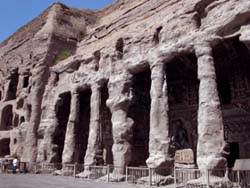 |
| [ Optional ] Datong: Datong is situated in northern Shanxi Province. It was the political, economic and military center of ancient North China. With a history of over 2400 years, Datong was the capital of Northern Wei (386~534) for 96 years, and the 'support capital' of Liao (916~1125) and Jin (1115~1234). |
|
| Day 2 Datong ( B,L ) |
| Drive 7km to visit Yungang Grottoes in the morning. Drive for 1 hour from Datong to see Hanging Temple and Wooden Pogoda in Yingxian county (75km south of Datong). It takes about 8 hours for today's sightseeing. |
| Hanging Temple | Hanging Temple stands at the foot of Mt. Hengshan, 5 kilometers (3 miles) south of Hunyuan County, and 65 kilometers (40 miles) from downtown Datong City. | | Yungang Grottoes | Yungang Grottoes, one of the three major cave clusters in China, punctuate the north cliff of Wuzhou Mountain, Datong. The area was excavated along the mountain, extending 1 km (0.62 miles) from east to west, revealing 53 caves and over 51,000 stone statues. | | Wooden Pagoda in Yingxian | Located in Yingxian County, and about 70 kilometers south of Datong, the Wooden Pagoda is the oldest and highest wooden structure in China. It is regarded as the 'First Pagoda in the World' and a gem in the architectural field. It has now also been placed under national emphases under the Cultural R…… |
|
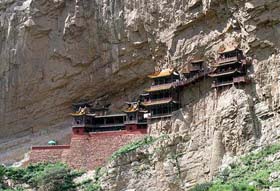 |
| [ Optional ] Datong food: Datong is mainly famous for its various wheaten food. Local people put wheat, pea, buckwheat, soybean sprout, tofu and peanut into boiling cooking pot, add vinegar together, and this type of noodle soup will be their main dish, 3 times everyday. People never get tire of foods made of noodle, and I was told that there are more than 100 kind of different noodle soups, with dozens of different seasoning. |
|
| Day 3 Datong, Pingyao ( B ) |
| Take K7807 to Pingyao(leave Datong at 07h45, arrive Pingyao at 15h06). Pick up at Pingyao railway station and transfer to the hotel. Visit Pingyao ancient town for the rest of the day. |
| K7807 train Datong to Pingyao | Train K7807 Datong to Yuncheng, stops at Pingyao. It depart Datong at 07h45, arrive at Pingyao at 15h06. Datong is the start station, it is convenient to book train ticket.
| | Pingyao ancient town | Pingyao is the middle of Shanxi Province, it is the best-preserved among the four ancient towns in China. It is the assembly place of folk houses in north China where rows upon rows of buildings in the Ming and Qing Dynasties stand in well-preserved conditions. |
|
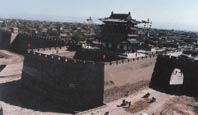 |
| [ Optional ] Rishengchang Draft Bank: The first draft bank of China, Rishengchang, is situated in the busiest section of Xi Da Jie, which used to be the First Street in the Qing Dynasty. Although it was only a small compound, it was a forerunner of modern banking and once manipulated the economic lifelines of the whole Qing Dynasty in the 19th century. |
|
| Day 4 Pingyao ( B,L ) |
| Continue our tour in Pingyao Ancient town, then drive to visit Shuanglin Temple, continue our driving to Taiyuan, visit Chang Family's Compound on the way. Later we'll drive to Taiyuan railway station for the train (soft sleeper class, 4 berths in one compartment) to Xian. |
| Pingyao City Wall | The original city walls of Pingyao were of tamped earth and were located northwest of the present Pingyao city, originally named Pingtao, was built in the early Northern Wei Dynasty. | | Shuanglin Temple | The Shuanglin Temple: Standing for more than 1500 years, the temple is famous for more than 2,000 painted sculptures of precious value, representing Ming and Qing Dynasties' best. They are reputed as a "treasure reserve of the oriental painted sculptures". | | Chang Family Mansion | It is a representative Shanxi merchant residence. Construction of the Chang family mansion began in the late Ming Dynasty. In 1770, during Qing Emperor Qianlong's reign, large-scale construction was carried out. |
|
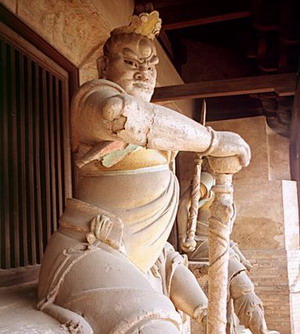 |
| [ Optional ] Train 2669 Taiyuan to Xian: The train runs from Taiyuan to Xian. Train No.: 2669. It leaves Taiyuan at 21h50, arrives Pingyao at 23h11, leaves Pingyao at 23h14, arrives Xian at 07h46 next day. The train has soft class with 4-berth ordinary soft class sleepers, 6-berth hard class sleepers and hard seats, public toilet (please prepare toilet tissue by yourself), restaurant car available. |
|
| Day 5 Xian ( B,L ) |
| Upon arrival at Xian railway station in the morning, pickup by our English speaking tour guide and drive to hotel to freshup and have breakfast. Afterward start our tours in Xian. |
| Xian Bell Tower | Built in 1384 A.D, the Bell Tower boasts a history of over 600 years. It is the largest and best-preserved of its kind in China. Visiting the Bell Tower, you can still see the Big Iron Bell which was made in Ming Dynasty, 2,500 kilograms in weight. | | Big Wild Goose Pagoda | It was built in 652 during the Tang Dynasty and currently boasts height of seven stories. It’s said that Master Xuan Zang built this pagoda to house the Buddhist scriptures and relics he had brought back from India. | | Terra Cotta Warriors and Horses Museum | Terracotta Warriors is the underworld terracotta army of Emperor Qin Shihuang (the first unifier of China, 259BC-210BC). It’s reputed as the Eighth Miracle of the World. Now the Terracotta Museum consists of Pit 1, Pit 2, Pit 3 and Pit 4 as well as the Hall of the two bronze chariots and horses. |
|
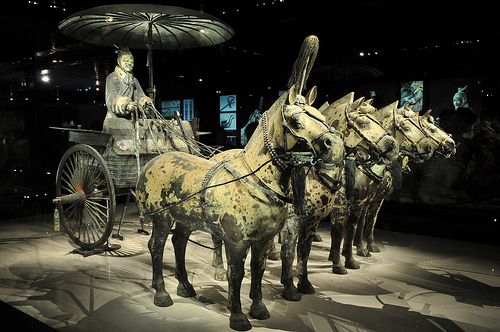 |
| [ Optional ] Tang Dynasty Dinner Show: The Tang Dynasty show has absorbed all the best music from the past dynasties and that of western regions and other countries. It vividly reflects their thriving economy, the friendly relationship between Tang and its neighboring countries, and the daily life of the Tang people. |
|